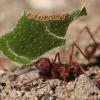So I managed to stumble across a Ponera pennsylvanica nuptial flight today. I only had one container, but I caught a queen. I'm a beginner at this hobby, so I'm not ready to keep them. I'm going to sell them, but in the meantime I'm going to have to care for them. I know nothing about this species except that the queens are semi-claustral, the colonies are small, and they are subterranean. How do I care for them? What do I feed the queen? how long does it take the workers to develop? How much would be a reasonable price to sell them at? PLEASE HELP!!
- Formiculture.com
- Forums
- Gallery
- Members
- Member Map
- Chat




















